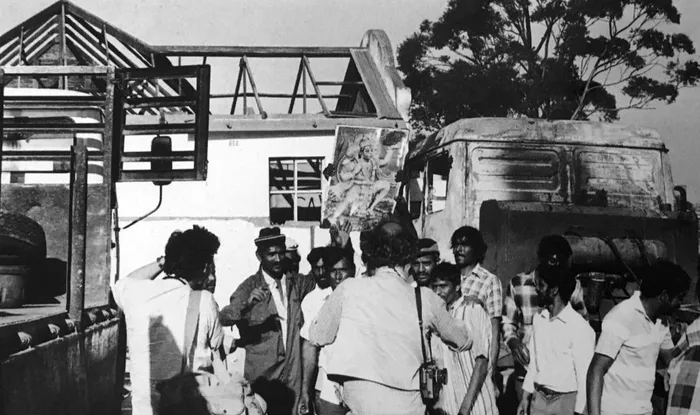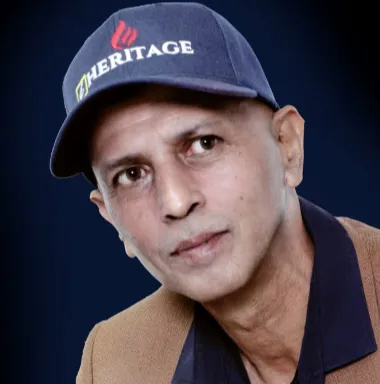The Inanda 1985 Riots: a community's struggle and resilience
40 years on we have risen from the ashes and ruin

Indian protestors gather to protect properties during the Inanda Riots.
Image: Omar Badsha
The Inanda 1985 riots marked a tragic turning point in the relationship between Indian and black communities in South Africa. NARENDH GANESH recounts the events leading up to the riots, the devastating aftermath, and the resilience of those affected, highlighting the importance of unity in the face of division.
IN THE main, Inanda, just north of Durban, was a fairly peaceful enclave inhabited primarily by Indian and black citizens, but relegated a distance away from the Durban CBD by the then Apartheid regime, in terms of the dastardly Group Areas Act.
Two communities, "far from the madding crowd", lived in relative harmony, as neighbours and as friends, until a few fateful days that shattered the tranquillity and harmony which devastated an entire community, leaving lives and livelihoods in ruins.
My father, Mr Deochand Ganesh, was the president of the then Inanda Child and Family Welfare Society that assisted many families, Indian and black alike, with solving domestic problems and indeed aiding in food relief to the very indigent and other assistance where needed.
Considered "rural" at the time, Inanda had farmers, transport operators, a few shop owners, market gardeners, three schools - one named after the wife of Mahatma Gandhi, namely Kasturba Gandhi Indian Government Aided Primary School, Wyld Memorial Government Aided Primary School and Inanda Government Aided Indian School - and most of the other Indian residents were weekly or wage earners, oftentimes eking out a meagre living.
The black community, by and large, were generally labourers, a few transport operators as well as a few businessmen.
My father, who had not realized it at the time, had become a pivotal figure in the aftermath of what ensued, related a story of what one petrol station owner, Mr Ramgobin (brother of NIC stalwart, the late Mr. Mewalall Ramgobin) had told him.
He related the fact that he had become curious as to why many black citizens were purchasing petrol in cans and other containers - an unusual occurrence.
Little did he realize that the petrol was going to be the nemesis of the trust between two communities that lived side-by-side, as brothers and sisters.
The serenity of this co-existence was suddenly shattered from what was then described as lower, mid and upper Inanda.
As if co-ordinated and pre-planned, Indian homes were looted, razed to the ground and violence had erupted as what was once friend became foe.
This betrayal was unheard of in this once peaceful community.
Families had to flee with only the clothes on their back, fearing their safety.
Tragically, a few citizens who returned to recover property were ambushed and murdered
On the night of 8 August 1985, my dad was awoken by a frenzied knock on the door.
It was familiar faces he recognized as residents of Inanda.
They hurriedly told him that their black compatriots were looting and burning their homes and vehicles and were stealing their domestic animals.
My dad had then immediately rallied members of the Inanda Child and Family Welfare Society and summoned the police - who informed him that they were "aware" of the mayhem and would "do whatever they could".
During this time, some community members of Inanda rallied together, like the Ramnarain brothers, who were transport operators, and began helping residents vacate the area and who had become refugees.
Members of the then House of Delegates such as Mr Amichand Rajbansi and Mr Baldeo Dookie pulled their resources together and expedited the protection of the refugees.
Greenbury Hall, Brindavan High School and other halls were made available to house the people.
Food aid, clothes, medical aid, with the help of the broader community, were made available to those affected.
Soup kitchens were set up as a temporary measure.
Under the leadership of Mr YS Chinsamy and Mr KT Manjee, the Inanda Relief Committee was set up to provide succour to the refugees.
My dad, together with Mr Shiner Ramkissoon, as head and vice respectively of the Inanda Child and Family Welfare Society were tasked by the House of Delegates to screen bona fide residents to give them letters authenticating their residence status for the purposes of re-housing.
This process continued unabated for two long years subsequent to the riots and those directly affected were provided with priority housing in Caneside, Foresthaven and Sunford in Phoenix.
Sadly but understandably so, there were many unscrupulous people who were not directly affected by the riots, but who attempted by various means to authenticate their bona fides but were outed through thorough and rigorous interrogation.
The government of the day offered a paltry R400 in vouchers to compensate for the losses incurred by the affected people.
Regrettably, to date, no lawful Commission of Enquiry was set up to determine the cause or the perpetrators of the unrest.
This has given rise to a great deal of speculation, even up to this day.
Forty years on, and many of the residents of Inanda have admirably moved on from this terrible and despicable event - becoming very successful and productive members of society, rising like the proverbial Phoenix from the ashes of rack and ruin.
The year 1985 was the second time in the history of South Africa that Indians were attacked. The first was in 1949, and a third regrettable event occurred in 2021.
The lessons from these terrible events must not overshadow the fact that South Africa is a country of one people, divided only by a bureaucratic classification of race, and that our common cause is a life of unity and togetherness that is inextricably locked for all eternity.
We must never forget Inanda 1985.

Narendh Ganesh
Image: File
Narendh Ganesh is a community activist and the leader of the National Independent Congress of South Africa.
** The views expressed do not necessarily reflect the views of IOL or Independent Media.